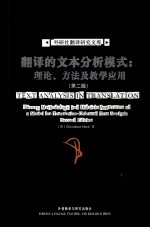

翻译的文本分析模式 第2版PDF电子书下载
- 电子书积分:11 积分如何计算积分?
- 作 者:(德)诺德(Nord,C.)著
- 出 版 社:北京:外语教学与研究出版社
- 出版年份:2006
- ISBN:7560059503
- 页数:274 页
Ⅰ.INTRODUCTION:The need for text analysis in translation 1
Ⅱ.A MODEL FOR TRANSLATION-ORIENTED TEXT ANALYSIS 5
1.Theoretical principles 5
1.1.Translatological foundations 5
1.1.1.Factors and constituents of the translation process 5
1.1.2.The role of the initiator 9
1.1.3.The role of the translator 11
1.2.Text-linguistic foundations 13
1.2.1.The text as a communicative interaction 13
1.2.2.The process of text reception 17
1.2.3.Text typologies 19
2.The role and function of source-text analysis 25
2.1.Possible relationships between source text and target text 25
2.1.1.Fidelity-liberty-equivalence 25
2.1.2.Skopos and intertextual coherence 27
2.1.3.Intercultural cooperation 30
2.1.4.Functionality plus loyalty 31
2.2.Phases of the translation process 34
2.2.1.The two-phase model 34
2.2.2.The three-phase model 35
2.2.3.The looping model 36
3.The factors of source-text analysis 41
3.0.General considerations 41
3.1.Extratextual factors 43
3.1.0.Basic notions 43
3.1.1.Sender 47
3.1.2.Sender's intention 53
3.1.3.Audience 57
3.1.4.Medium 62
3.1.5.Place of communication 67
3.1.6.Time of communication 70
3.1.7.Motive for communication 74
3.1.8.Text function 77
3.1.9.The interdependence of extratextual factors 83
3.2.Intratextual factors 87
3.2.0.Basic notions 87
3.2.1.Subject matter 93
3.2.2.Content 98
3.2.3.Presuppositions 105
3.2.4.Text composition 110
3.2.5.Non-verbal elements 118
3.2.6.Lexis 122
3.2.7.Sentence structtre 129
3.2.8.Suprasegmental features 131
3.2.9.The interdependence of intratextual factors 139
3.3.Effect 143
4.Applications of the model in translator training 155
4.0.General considerations 155
4.1.Planning the process of translation training 161
4.1.0.Fundamentals 161
4.1.1.Selecting texts for translation classes 162
4.1.2.Grading the difficulty of translation tasks 165
4.1.3.Grading the difficulty of translation texts 172
4.2.Classifying translation problems 174
4.3.Testing transfer competence 177
4.4.Assessing translation quality 179
4.4.0.Forms and functions of translation criticism 179
4.4.1.Translation criticism vs.translation comparison 181
4.4.2.A didactic model of translation criticism 182
4.4.3.Defining translation errors 186
4.4.4.Evaluating translation tasks 188
5.Sample texts 191
5.0.General considerations 191
5.1.Text 1:The relationship between intention and function-Alejo Carpentier:Acerca de la historicidad de Victor Hugues 192
5.1.0.Text 192
5.1.1.Analysis of extratextual factors 193
5.1.2.The postscript Acerca de la historicidad de Vícto Hugues 194
5.1.3.The reflection of the extratextual factors in the text 195
5.1.4.Analysis of intratextual factors 197
5.1.5.Analysis of effect 200
5.1.6.Translation criticism 201
5.1.7.Conclusions and suggested translations 217
5.2.Text 2:The relationship between subject matter,text structure and effect-Miguel de Unamuno:Niebla 223
5.2.0.Text 223
5.2.1.Analysis of extratextual factors 223
5.2.2.The beginning of a text as a key to its interpretation 224
5.2.3.Some considerations on ironic intention 225
5.2.4.Analysis of text structure 227
5.2.5.Translation criticism 234
5.2.6.Conclusions and suggested translations 240
5.3.Text 3:The relationship between text function and audience orientation-Tourist information:SPEZIALIT?TEN 243
5.3.0.Text 243
5.3.1.Analysis of extratextual factors 243
5.3.2.The relevance of audience orientation 244
5.3.3.Analysis of intratextual factors 244
5.3.4.Translation criticism 250
5.3.5.Conclusions 256
Ⅲ.FINAL CONSIDERATIONS 257
Ⅳ.INDEX OF TRANSLATION PROBLEMS 263
Ⅴ.INDEX OF EXAMPLES 264
Ⅵ.REFERENCES 265
- 《水面舰艇编队作战运筹分析》谭安胜著 2009
- 《分析化学》陈怀侠主编 2019
- 《英汉翻译理论的多维阐释及应用剖析》常瑞娟著 2019
- 《当代翻译美学的理论诠释与应用解读》宁建庚著 2019
- 《影响葡萄和葡萄酒中酚类特征的因素分析》朱磊 2019
- 《仪器分析技术 第2版》曹国庆 2018
- 《全国普通高等中医药院校药学类专业十三五规划教材 第二轮规划教材 分析化学实验 第2版》池玉梅 2018
- 《Power BI数据清洗与可视化交互式分析》陈剑 2020
- 《社会文化系统中的翻译》姜秋霞,杨正军 2019
- 《2020考研英语大趋势 历年真题完形+翻译+新题型精讲精练》商志 2019
- 《中风偏瘫 脑萎缩 痴呆 最新治疗原则与方法》孙作东著 2004
- 《水面舰艇编队作战运筹分析》谭安胜著 2009
- 《王蒙文集 新版 35 评点《红楼梦》 上》王蒙著 2020
- 《TED说话的力量 世界优秀演讲者的口才秘诀》(坦桑)阿卡什·P.卡里亚著 2019
- 《燕堂夜话》蒋忠和著 2019
- 《经久》静水边著 2019
- 《魔法销售台词》(美)埃尔默·惠勒著 2019
- 《微表情密码》(波)卡西亚·韦佐夫斯基,(波)帕特里克·韦佐夫斯基著 2019
- 《看书琐记与作文秘诀》鲁迅著 2019
- 《酒国》莫言著 2019
